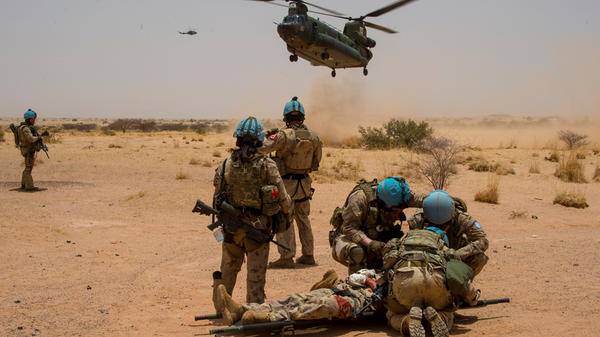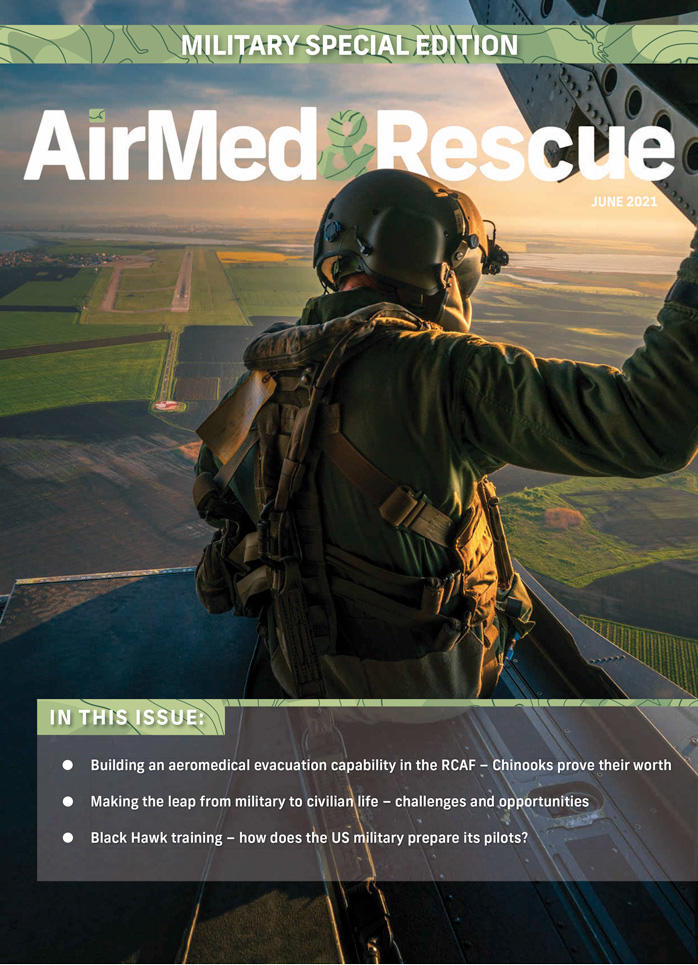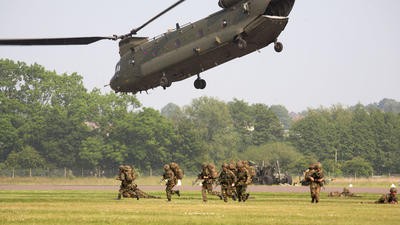Building a military aeromedical evacuation capability

Dr Joetey Attariwala looks in-depth at the latest versions of Royal Canadian Air Force Chinook helicopters, which are proving invaluable in their aeromedical evacuation role in Africa
Canada has a long and distinguished history of providing high-value military capabilities for United Nations (UN) peacekeeping missions around the world. Such efforts were recently exercised in Mali, where Canada provided support through financing and deployments within the United Nations Multidimensional Integrated Stabilization Mission in Mali (MINUSMA).
As part of this mission, the Canadian Armed Forces (CAF) were tasked to develop and provide an aeromedical evacuation capability integral to the Air Task Force which deployed under Operation PRESENCE - Mali, which supported MINUSMA. This support allowed UN partners the freedom to conduct long-range security operations in remote and vulnerable areas of the country. Aircraft within the Air Task Force consisted principally of Royal Canadian Air Force (RCAF) CH-147F Chinook and CH-146 Griffon helicopters.
Building the aeromedical capability
RCAF Colonel Chris McKenna was the Air Task Force Detachment Commander for the Mali mission, and he spoke to AirMed&Rescue about the capability that was developed: “If we think back to our time in Afghanistan, Canada didn’t have a dedicated aeromedical evacuation capability, so we relied on our US and British allies for that. The extent of our own expertise resided in CASEVAC (Casualty Evacuation) where we’d scoop a person up and get them to the hospital as fast as we could, but there wasn’t really any ongoing care in the back. In 2017, we were told to anticipate a UN peacekeeping mission that would likely consist of an aviation medevac capability, so we started to seek advice on developing this capability from our colleagues with the US Army, the Royal Air Force and the Dutch Air Force.
“We specifically had a very good look at the Brits because they used the Chinook in Afghanistan for their Medical Emergency Response Team (MERT), where they would carry doctors, nurses and some paramedics,” McKenna explained. “We ultimately based our medevac solution on our CH-147F Chinook because of its size and space, it’s extended range fuel tanks, and because you can also add complementary capabilities like counter-IED and K-9 teams, or force protection teams to the package without compromising the ability to manage patient load.”
Planning for the medevac mission kicked into high gear with the development of tactics, techniques and procedures that were in line with best practices of the aforementioned allied nations. Initial planning cued off experiences from the Afghanistan theater of operations, which McKenna described as having all the ‘enablers’ of a coalition combat mission.
It was decided that the Air Task Force would consist of approximately 250 personnel, along with three Chinook helicopters that would conduct medical evacuations, and five Griffon helicopters that would fly as armed escorts. This mission was the first operational overseas deployment for Canada’s new Chinook helicopters, and the first time they were tasked with a medical evacuation role.
The overall deployed capability had three key elements – the aircraft, the medical team, and a force protection team, which collectively are called the Canadian Medical Emergency Response Team (CMERT).

© Courtesy DND - A CH-147F Chinook and CH-146 Griffon conduct an aeromedical evacuation exercise during Operation PRESENCE-Mali
The Axnes PNG system's evolution into the most capable wireless ICS for all mission types - SPONSORED CONTENT
Axnes explains how its PNG (Polycon Next Generation) wireless intercommunications system (ICS) frees crewmembers from the encumbrance of wired connections to an aircraft or other platform intercom system, while minimizing the potential
PNG’s wireless solution provides the ability for crewmembers to move freely within, as well as outside, the aircraft, while maintaining real-time communications with all crewmembers, enhancing both situational awareness and safety. Crew can be equipped with a PNG handset transceiver; either the MP30 (water resistant) or MP50 (waterproof) models that communicate with a PNG base station on the aircraft (fixed or mobile installation). This provides secure (AES 256 grade encryption) and line-of-sight full-duplex UHF communications with robust noise- and echo-cancelling features, which enhance mission capability and operational safety under the most challenging scenarios, particularly during hoist missions. PNG also includes a GPS positioning feature for both model handheld transceivers. When integrated together with a moving map system on an aircraft, it allows for continuous tracking of dismounted crewmembers.
The Axnes PNG system is compatible with a wide variety and brands of headsets and helmets. It automatically adjusts to the impedance level of any headset or helmet, whether it be a low or hi-impedance design.
User feedback influences product design
The Axnes PNG system has matured over the last few years, and has benefited from important user feedback and recommendations from customers in the airborne public safety, firefighting and utility, and special mission user communities, all of which have contributed to improving PNG’s capabilities and reliability. From software to antenna upgrades and other improvements, PNG has evolved into the most robust and capable wireless ICS on the market for all mission types – aviation, ground vehicle, and maritime operations.
Chinooks in a medevac role
Each Chinook would deploy with a five-person aircrew, a four-person Army force protection team, and a four-person medical team, which consisted of a flight surgeon, critical care nursing officer, and two medical technicians. Once in theater, the team would stand on medevac alert 24 / 7, with a 30-minute notice to move. This response time was continually honed, with teams eventually launching off the ground in as quick as 18 minutes from receiving an alert call.
According to Lieutenant-Colonel Richard Hannah, 1st Canadian Division Flight Surgeon, the entire CMERT package can be configured or de-configured in the cabin of the Chinook in approximately one hour.
“Our mandate was to do medevac in a high-risk theater, so we started equipping our Chinooks in line with the British model, but we also brought in some specific capabilities that had never been deployed before, like REBOA (Resuscitative Endovascular Balloon Occlusion of the Aorta),” said Hannah. “It’s a capability that allows us to stop bleeding anywhere below the site of application, and it’s only used when you can’t compress blood vessels to stop bleeding. Thankfully we never had to use it.
“The CMERT equipment is all rucksack-based, which you hang on the wall in very specific places. We had at least two ventilators on each aircraft, Propaq MD monitor and defibrillators, suction, IV pumps, oxygen and ultrasound imaging devices. We could carry up to 20 units of blood and we also carried freeze-dried plasma (FDP). The normal load was four units of blood, but we could increase that to 20 if we knew we were responding to a mass casualty event. Having blood and FDP was decisive in saving lives; it’s a lot better than putting saline in, because the fundamental tenant in my mind for damage control resuscitation is to replace blood with blood and stop the bleeding,” said Hannah.
Comms and connectivity you can rely on - SPONSORED CONTENT
Flightcell’s DZMx system are reliable and robust, with thousands of airborne systems on the Iridium Network operating for military and first responder operators in some of the worlds harshest environments
Communications between flight crews and from the ground to Air units are key in Military medevac scenarios, and Flightcell’s DZMx system connects to the Iridium Network, so the connection reliability is approaching 100 per cent for a transceiver with a clear horizon to horizon view of the sky. The Flightcell DZMx has modular hardware, allowing operators to select connectivity options (satellite, cellular, Bluetooth and Wi-Fi) as well as hardware expansion options for connecting onboard systems, multiple sensor inputs and additional data processing options.
In the air medical sector, connected equipment includes wired and wireless connections to patient monitoring devices, transmission of patient data (over a virtual private network (VPN) if needed), and remote dialling capability for the medical crew over remote dialling heads and/or connected Smart devices.
With the pending discontinuation of 3G networks around the world, Flightcell is rolling out replacement modems to move to 4G VOLTE networks, and has introduced a US-specific modem with Band14/FirstNet capability. The only system to do so for the airborne first responder community.
Satellite and cellular tracking working in tandem
Flightcell was the first company to launch IP-based tracking over the cellular network. This provides high-frequency transmission of real-time position data whenever the Flightcell DZMx is in range and connected to a cellular network. When out of cell network range, the system automatically defaults to satellite transmission of Short Burst Data packets (SBD) when back in cell range the SBD switches to IP over cellular. This provides for lowest-cost tracking for operators.
Flightcell DZMx is an agnostic terminal, so military and commercial operations can track their assets over their current mapping system. Data is sent DIRECTLY from DZMx to the mapping server. There is no need for a second mapping service, no re-routing of data, and no hidden transmission costs via a 3rd party server. This allows for full flexibility of provider choice and better control over the security of the data.
Standardizing medical equipment and procedures
Because multiple teams were deployed, all medical procedures were formalized across the entire enterprise, such that everyone would use common drugs and procedures in case communications were interrupted. “It has to be standardized in order to be safe,” said Hannah. “We also realized that the force protection team was available to help with the patients once we got airborne, so we used them more and more, and that came in particularly handy when we had multiple casualties.”
One of the lessons learned from British colleagues was the corrosive nature of blood. Hannah added: “That insight led us to construct a waterproof membrane which we would put on the floor of the Chinook, on which the patients would be positioned. We also put foam underneath the membrane so our teams wouldn’t need to wear knee pads.”
Another huge enabler for the CMERT was a wireless hands-free closed network intercom system for the medical team, which allowed them to talk among themselves without interfering with the duties of the aircraft crew. To enable a clear and efficient interface between the teams, a single medic would have the ability to speak with the flight crew. That person was also able to patch into the tactical network to communicate a MIST report to the patient evacuation center. In addition, each of the teams within the CMERT was assigned a callsign on the inter-plane frequency, which means each team acted like its own unit in the overall formation. (MIST report stands for: M – mechanism of injury (mine, GSW, RPG, RTA,); I – type of injury (found and or suspected); S – signs (pulse rate, blood pressure, respiratory rate); T – treatment is given (morphine, tourniquet).

© Courtesy DND - Canadian Medical Emergency Response Team (CMERT) conduct a aeromedical evacuation exercise aboard a CH-147F Chinook helicopter in Mali
Mali is a complex airspace to work in
Operating out of Gao, Mali, the Air Task Force traversed large areas of the country, which posed a complex set of high-risk challenges superimposed to a peace support mandate. “It’s a much less enabled space because the UN does not have unlimited assets sitting atop the country,” explained McKenna. “There were three other military helicopters from El Salvador on the mission when we were there, but Mali is a huge country, so we realized there’s really no one to back us up if we lost a helicopter for example, so we would also stand-up an in-extremis personnel recovery element every time we launched on a medevac mission in case we needed it.”
The first major incident that the CMERT responded to was a 70-vehicle convoy that encountered a double-stacked anti-tank mine. According to McKenna, the driver and passenger of the truck that bore the brunt of that blast lost both of their legs.
“We resuscitated one of those men about four times on the way back to the hospital. Thankfully both of them lived,” said McKenna. “The largest scene we responded to was a Forward Operating Base (FOB) in Aguelhok, which is in the north of Mali, and was manned by a company of peacekeeping troops from Chad. That FOB was surrounded and attacked by what we believe was JNIM (Jama’a Nusrat ul-Islam wa al-Muslimin) terrorists who used vehicles with heavy weapons, mortars, suicide vehicle-born IEDs, and a series of suicide bombers. We responded immediately, and in the end there were about 25 category A or B casualties and 10 killed in action. Our first aircraft took the eight worst casualties all the way back to Gao, unescorted, which was 200 nautical miles away – that meant the clinicians were rendering surgical intervention for over an hour and a half. I can tell you that having the extended range fuel tanks on our Chinooks fundamentally saved a lot of lives on that day. Every single Chad peacekeeper that was placed on our Chinooks alive got off alive, which I think is the biggest testament to that day.”
Canadian military helicopters achieve mission success
The Air Task Force operated for a year out of Gao, conducting 11 medical evacuations and more than 100 transport missions. The Canadian helicopters accumulated more than 4,000 flying hours, transported approximately 2,800 passengers and delivered more than 370,000 pounds of cargo.
The CMERT was established specifically for the UN mission in Mali, however, its success has led the RCAF to now include it as a persistent capability in its order of battle. “What we have developed is a world-class aeromedical capability which we can deploy anywhere around the world, and I firmly believe that we can now hold our own amongst our British, Dutch or American colleagues,” said Hannah.

June 2021
Issue
In this issue:
- Building an aeromedical evacuation capability in the RCAF – Chinooks prove their worth
- Making the leap from military to civilian life – challenges and opportunities
- Black Hawk training – how does the US military prepares its pilots?
- Giving old aircraft a new lease of life as aerial firefighters
- Interviews: US Air Force PJs past and present; Dr Neville Vlok, HALO Aviation
- Provider Profile: Keewatin Air
Dr Joetey Attariwala
Dr Attariwala trained as a medical doctor and has established himself as a highly regarded journalist who contributes to various aerospace, defense, training and simulation, and law enforcement publications around the world. He is a regular contributor to AirMed&Rescue magazine.





